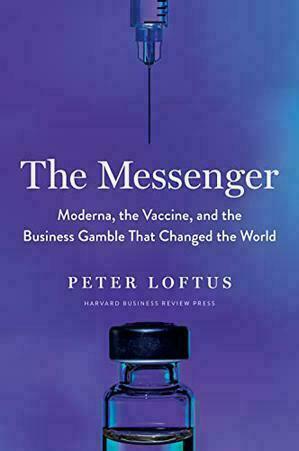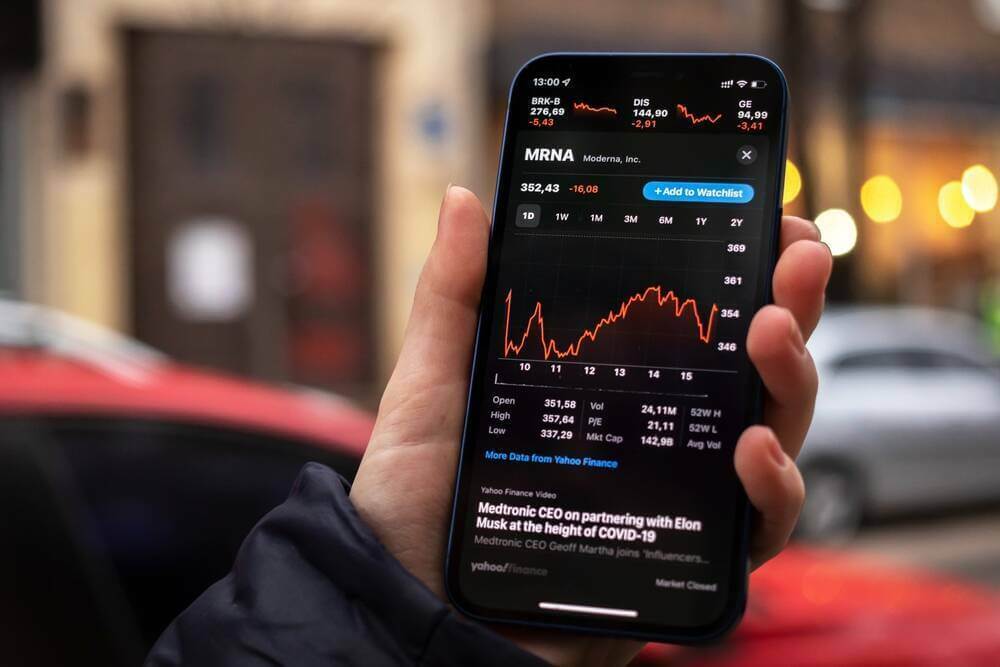
Moderna began researching mRNA medicines in 2011, and for nearly a decade few people other than venture capitalists had heard of the biotech startup. At the start of 2020, the mRNA technology that the company and its investors were banking on had not yielded a single product. Then the green flags waved in the race to develop a COVID-19 vaccine.
Moderna was in an ideal position to meet that global need — and to profit from taxpayer investment in accelerated vaccine development. The Messenger, a new book by Wall Street Journal reporter Peter Loftus ’92, gives readers an inside look at Moderna before and after its breakthrough.
“Moderna was sort of a mysterious character in the pandemic,” Loftus says. “They were virtually unknown before the pandemic, and then found themselves in the right place at the right time with the right technology to wage a response to the COVID pandemic.”
Covering pharmaceuticals and biotechnology for the Journal, Loftus followed the vaccine race in real time. Amid the barrage of news on his beat during the pandemic, he grew more curious about Moderna as its mRNA research rocked to relevance.
Messenger RNA technology changes the nature of treating disease. Traditional viral medications and vaccines introduce specific proteins into the body to trigger immune responses. Moderna designs mRNA medications to supply a script for the body to make its own disease-fighting proteins.
The company’s mRNA COVID vaccine enters a muscle cell and produces part of the spike protein found on the surface of the COVID-19 virus. Cells then break down the mRNA while the spike protein triggers an immune response that teaches the body how to fight off COVID.
“With Moderna in particular, they spent 10 years before that really trying to be a pioneer of this messenger RNA technology that they viewed as a platform for designing a bunch of new vaccines and drugs, not just one product,” Loftus says. “Up until 2020, there had never been a drug or a vaccine that was based on messenger RNA technology. Even though Moderna believed in the potential, and some experts and investors believed in its potential, there were still a lot of skeptics who thought this might not amount to much.”
Moderna forged ahead anyway, completing the race in second place with a photo finish behind another mRNA vaccine developed by pharmaceutical giant Pfizer in collaboration with BioNTech. Loftus was struck by the speed and effectiveness of the new mRNA vaccines. Combined with Moderna’s little-guy appeal, he caught the bug for a fascinating book idea.
“Normally any vaccine — and really a lot of drugs too — can just take years and years to develop,” he says. “To go from that to — really the timeline was from January to December of 2020 — 11 months, that’s pretty unprecedented.”
Despite such a fast turnaround, Moderna created a vaccine so effective it may have surprised even the company’s biggest believers.
After a decade of pouring resources into mRNA technology, Moderna finally had a product — one that would be a part of a historic vaccination campaign that administered more than 12.3 billion doses around the world. Moderna’s stock price, meanwhile, jumped from less than $20 per share at the beginning of 2020 to more than $400 per share in September 2021. At one point, the company’s market value briefly surpassed $200 billion.
Inspired by Moderna’s speed, efficacy and dramatic business upturn, Loftus decided to expand on his newspaper reporting in The Messenger, published in July by Harvard Business Review Press. He took a summer 2021 leave from the Wall Street Journal, tracking down current and former Moderna executives to capture the extent of the company’s pandemic transformation.
The Messenger features colorful characters like Moderna’s CEO Stéphane Bancel, “very driven from a young age to at some point be the CEO of a company, and ideally be the CEO of a company that was just starting from scratch,” Loftus says. “That’s what he did with Moderna, and he was really hard charging and unsparing, to the point where there was definitely bad blood at a certain point between him and some of the early employees.”

The action largely takes place in Cambridge, Massachusetts, in the Kendall Square neighborhood near the Massachusetts Institute of Technology — what Loftus calls a “real hotbed of biotech.” That location is important for another trend Loftus explores in the book: the emergence of biotech research startups empowered by venture capital funding to compete against pharmaceutical giants.
“Moderna is very much a creature of this shift over the last couple of decades where it’s not just these big, well-known drug companies that are coming up with these new medicines. There’s this whole new ecosystem of biotech companies that are really harnessing amazing discoveries in research labs,” he says. “And there’s this whole financial structure for that, of venture capitalists. They’ve got tons of money to invest, and this is money from university endowments or pensions, and they’re looking for big returns. A way they can do that is investing in these biotech companies, knowing that some might fail but some might hit it big. There can be a big payoff for that, both financially, and for science and medicine.”
The success of COVID vaccine development does not tie a bow on a perfectly wrapped story about the convergence of science and business. A slew of questions simmers over vaccine hesitancy, waning vaccine protection, government-funded company profits and the U.S. healthcare system itself, Loftus says. The biotech and pharmaceutical industry that produced the vaccines is the same one sparking debate over the triumphs and troubles of profit-driven healthcare.
“The ecosystem that contributed very much to the COVID vaccines also yields new drugs for cancers and rare diseases that are coming with prices that are astronomical,” Loftus says.
Moderna’s situation also draws skepticism regarding the ethics of a government-funded vaccine campaign that makes some business executives billionaires. The federal government provided the company $1.7 billion for research and testing through the Biomedical Advanced Research and Development Authority. After the first six months of this year, taxpayer dollars have also generated about $8 billion in revenue for the company via supply contracts. Another $1.74 billion deal with the U.S. government to provide 66 million booster doses was announced in late July.
Moderna’s chairman and one of its founders Noubar Afeyan, board member and founder Robert Langer and early investor Timothy Springer were among the top 400 richest people in America in 2021. Their fortunes have declined along with Moderna’s stock price, but they remain billionaires. Bancel also has a current net worth of more than $5 billion.
“In 2020, a big source of [Moderna’s] money came from taxpayers. They got a lot of government money, grants and supply contracts that almost took away the financial risks to embark on a high stakes vaccine development campaign,” Loftus says. “There’s been some criticism of the company because this whole process of developing a COVID vaccine, often with a lot of public support, government support, taxpayer support, did have the effect — because they were successful — of boosting the stock market value of the company, and in turn, enriching the executives.”
Loftus hopes to “leave fodder for people to have that discussion and debate” over these contentious questions.
Loftus’ recent pharmaceutical coverage for the Wall Street Journal includes stories about the approval of Novavax, a new non-mRNA vaccine. He’s also written about excess supply of COVID vaccines, with 30 million doses of Moderna’s biggest accomplishment landing in the waste can.
Trashed doses “might have seemed unimaginable” at the start of 2021, he says. Then again, a new mRNA vaccine approved in less than a year might have seemed even more unimaginable at the start of 2020.
Loftus and The Messenger tell that unlikely story.
Maggie Eastland is a junior at Notre Dame studying finance and journalism. Powered by a few too many cups of coffee and daily stock market email newsletters, she is also assistant managing editor at The Observer.